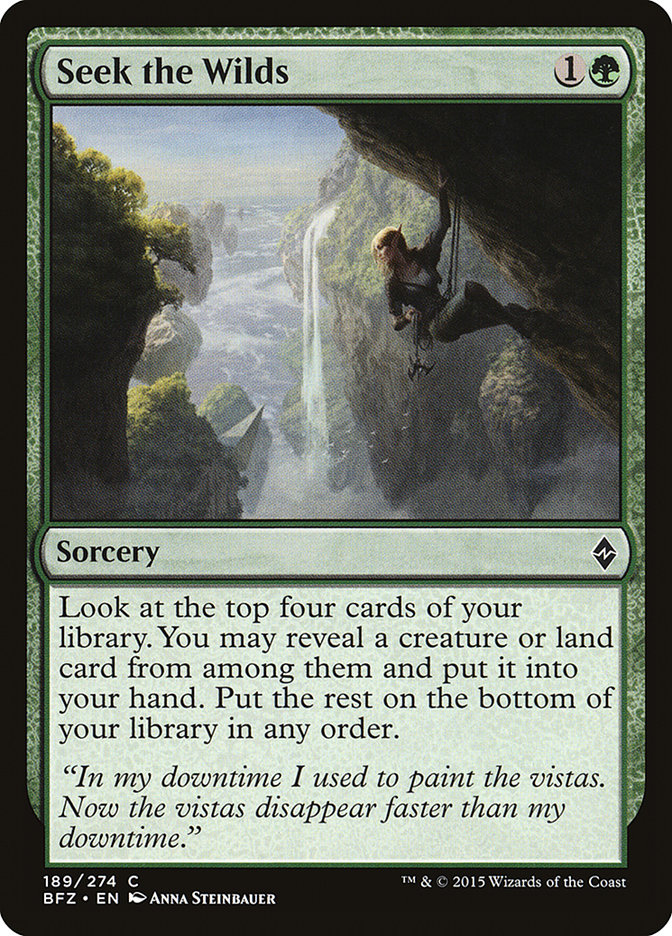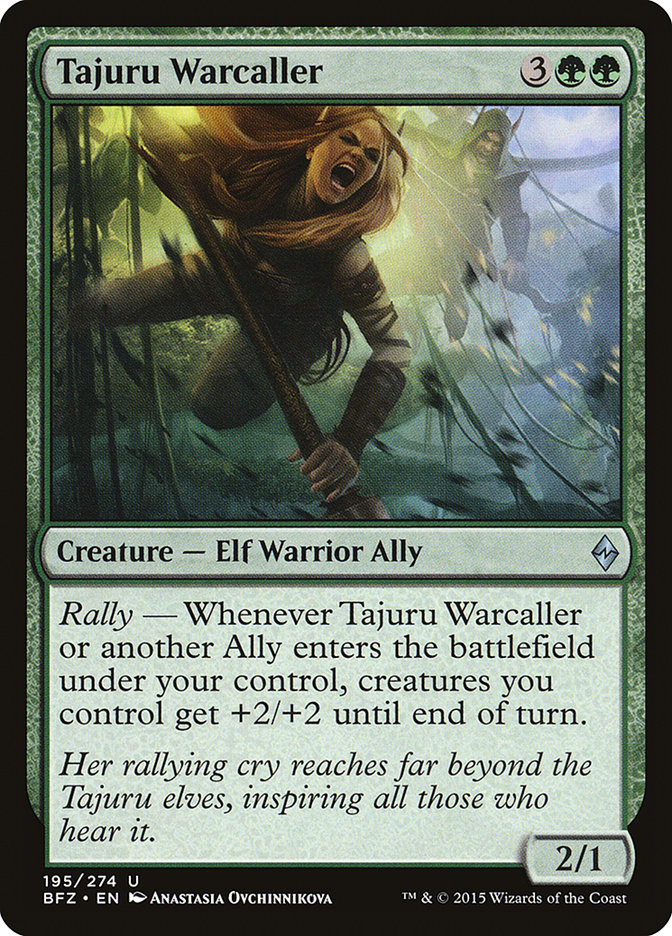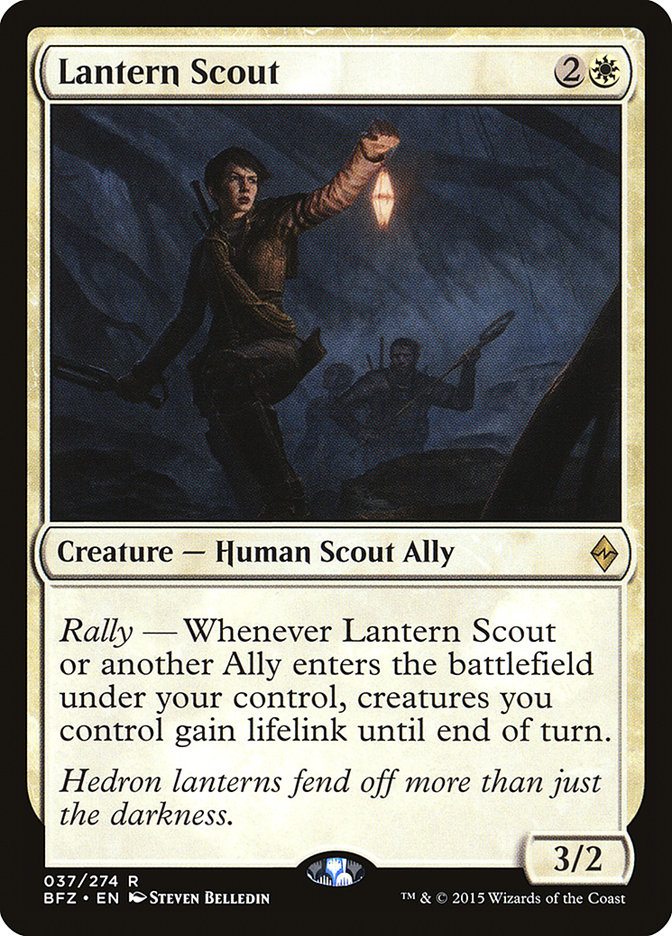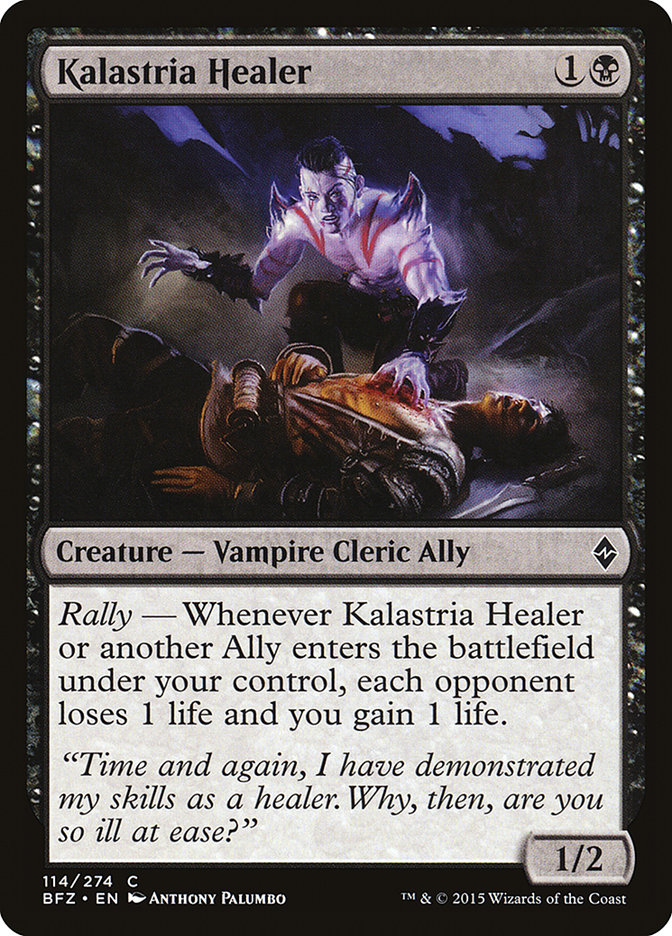Grand Prix Atlanta is coming up in two weeks. I’m personally expending all of my game play effort getting maximally proficient with the decks I’ve locked
into for Grand Prix Seattle the week before and Grand Prix Pittsburgh a week after. I don’t have the time to iterate large numbers of high round count
Sealed events–if they even still exist on Magic Online.
Fortunately, literally thousands of people have done this before me, and I have the results to look at.
Sixteen undefeated Sealed decklists have been posted from the three previous Battle for Zendikar Sealed Grand Prix:Madison,Lyon, and Sydney (a 17th 8-0-1 list from Lyon was left out).
These decks are the exemplars, what a winning Sealed deck should look like.
Color Split
These are the colors played among the winningest decks:
- White – 12/16
- Blue – 9/16
- Black – 5/16
- Red – 9/16
- Green – 5/16
Given an even distribution, every color should have eight representatives. Short version: that’s a lot of white and very little black or green. We’ll get
into why the colors are split this way as we discuss the different other aspects I’ve tracked, but there’s another big point to make here.
You may notice that total is more than default 32 total colors represented if each deck is two colors. Significantly more. Half of the decks here were
three colors. No four- or five-color decks, just three.
There’s another interesting layer of this: a lot more of these are solid three-color decks than you would expect. Four of them have the classic 6/6/6
manabases (one Esper, one Jeskai, one Naya) or 7/6/5 (Bant), and another is slightly better at 8/4/4 with an Evolving Wilds (Naya, base green).
The other three are more traditional cases of “I have an Evolving Wilds and a cool card to splash.” Brutal Expulsion and Vile Aggregate in U/B Devoid; Sire
of Stagnation, Fathom Feeder, and Roil Spout in W/B; or Veteran Warleader in G/R.
Worth noting on that last G/R deck: it played a single Plains and a Seek the Wilds to get it…but had two Tajuru Stalwarts to make into much more
impressive 3/4 bodies when it actually hit the splash land. I wouldn’t default to adding off-color lands to cast my converge cards, but it’s easy to
imagine going down that road. In this case, the deck wanted the Tajuru Stalwarts as Allies due to a Chasm Guide, Tajuru Beastmaster, and Tajuru Warcaller,
so it wanted the extra color to make them good, which let it play the Ally rare in Veteran Warleader. Now imagine you had a Woodland Wanderer, which you
are playing as a really efficient creature even in just a two-color deck. You are looking at a Sheer Drop in your sideboard with just a Lifespring Druid to
fix…yeah, that now makes the cut because the white land actually has an effect besides casting the splash spell.
Don’t be afraid of splashing in this format. In fact, don’t even rule out full on three-color decks. I remember looking at my pool in Madison and thinking
a lot of the simple two-color builds looked terrible, and now I’m starting to see that was a poor place to start.
Looking at the eight two-color decks, we have the following breakdown:
- White – 5/8
- Blue – 4/8
- Black – 2/8
- Red – 4/8
- Green – 1/8
Most of the numbers are similar to the three-color split, but only one two-color deck was green. Oddly enough, the three-color green decks don’t really
have that much actual green fixing either. One Lifespring Druid, one Natural Connection, two Fertile Thicket between four decks.
One other thing I’m noticing now is that of the five black decks, zero were base red or green. There was one full Esper, two B/W–one of which splashed
blue–and two U/B, one of which splashed red. Green, on the other hand, always went with white in the three-color decks and was G/R in the one two-color
deck. As with the above color comments, we can get to why this is a bit later as we go through the other metrics.
Cool Fact:
7/9 blue decks had Eldrazi Skyspawner. Three of those had multiples. How does anyone ever beat that card?
Lands
Thirteen of the sixteen decks played eighteen lands. Of the three that didn’t, more played nineteen than seventeen. The seventeen-land deck was even a full
on three-color deck with no Fertile Thickets, which is absolutely absurd to me.
This is not a surprise. Basically everyone has been saying that you want eighteen lands in Draft, and Sealed is only going to be less streamlined and have
decks playing higher up the curve. If you are supposed to be looking at three-color decks in Sealed, that 18th land helps make all of the source counts for
each color work out.
The mechanics also push higher on land counts. It isn’t just Awaken, which is awesome and all over the place in these decks (shocking, all the different
Shriekmaws are good in Sealed deck), and landfall, but all of the spell-lands. Most of these decks are playing at least one of the various options:
Blighted lands, Spawning Bed, or the Fertile Thicket cycle. There’s actually a surprising number of what I considered to be the worse ones in the cycle.
I’m not the biggest fan of Sandstone Bridge, Skyline Cascade, or Blighted Gorge in Draft, but these are cards that keep showing up in these lists. I think
the lesson at the end of the day here is to play them if you have them, even in the three-color decks. As per above, the 6/6/6 manabase is apparently
better than it looks, so presumably with an Evolving Wilds you can start doing crazy stuff like playing a colorless value land in your full on three-color
deck.
Looking at the numbers, this is pretty clearly the case. The average undefeated deck has around three two-drop plays. Only a single deck has five, and
multiples have a single two-drop. This even includes things like Horribly Awry and Gideon’s Justice, not just creatures. This isn’t Magic Origins
with Topan Freeblades and Fiery Impulse. If you miss your third land drop, you straight up aren’t playing Magic. You may recognize this as the same reason
you played eighteen lands in morph formats like Khans of Tarkir, with the slight twist that in this format the two-drops are actually not
that good instead of being just bad relative to morphs in Khans.
I unfortunately don’t have good data on playing nineteen lands over eighteen lands here. Laurent Favier’s deck is probably a good example of when to move
in this direction. Two colorless lands, Omnath, Locus of Rage, and Stasis Snare. As for seventeen…yeah, don’t press your luck. Maybe there’s a two color
W/B Allies deck that lines up perfectly, but I doubt it.
Archetypes
Three things here: what’s present, what’s missing, and a couple big picture things.
There are a lot of Allies decks. This is largely because Resolute Blademaster, Tajuru Warcaller, and Lantern Scout are very powerful cards and a lot of the
other Allies are solidly playable. If you have one of these cards, you are drawn to play a few more Allies, as your filler tries to make them as good as
possible.
There are a few Eldrazi decks. This is going to be me more talking from personal experience, aka BBD beating the crap out of me at Grand Prix Madison. If
you have multiple Kozilek’s Channeler, Hedron Archive, or Conduit of Ruin suddenly casting a seven- or eight-drop gets really easy, to the point that
multiples are probably doable. This is also a truly colorless strategy. Willy Edel opened two Kozilek’s Channelers at Grand Prix Madison and went R/W
Eldrazi, which are basically the two colors least equipped to support giant monsters.
There’s a lot of the awaken side of U/W and a little bit of fliers. The defenders part of U/W also plays well if you are building to Eldrazi. Damien Mace’s
deck from Grand Prix Lyon shows a bit of this, with zero of the previously mentioned ramp cards, but three Eldrazi to build to.
There are a couple Devoid/Ingest decks. These are mostly two-color decks, and as mentioned above, U/B or U/R, not B/R. They are relatively light on
enablers for the most part, which is to be expected for Sealed. You have less packs to find all the commons you need. The deck with the most Mist Intruders
is a U/W fliers deck, not an Ingest deck. Worth noting: one of the Ingest heavy decks was also a discard heavy deck with Mire’s Malice and Mind Rakers.
This is a very real strategy if you have the curve to choose to draw first.
There is almost no landfall. Grove Rambler shows up a lot because it’s straight up great, but there’s a single Valakut Predator among all of the undefeated
decks. This is probably an anomaly if I’m being honest. Looking at the red decks here, you see three-color decks that are solidly red but not necessarily
in the market for a medium impact, aggressive only body. There’s just enough red aggro that it clearly isn’t impossible, and honestly I think this is
likely more a case of the red decks that want the card didn’t open one. Sixteen decks is still a small sample set to draw conclusions from in some
situations.
There are no Kalastria Healers, no Serene Steward, no Bloodbond Vampire. There’s a couple Nirkana Assassin, Stone Haven Medic, and Kalastria Nightwatch,
but that’s just a small package and not a major way the decks with them are winning games. I’m sure it’s possible to open pools for this, but often you are
going to see something like the Devoid decks where you are just missing a little bit of it. In the case of lifegain, you need a lot of moving parts.
Kalastria Healer is only great in multiples, and Serene Steward and Bloodbond Vampire are bricks without help. In an eight player draft they are opened out
of 24 packs and float to the people who want them, but in six packs you aren’t getting a big enough sample size.
This last point both A) is always true in Sealed and B) really informs how you have to build for this format. You aren’t going to have a full on archetype
most of the time, and if you are it’s going to be because a subset of five or six cards lets you do this like in the Eldrazi decks. Find the packages that
exist in your pool and figure out how to integrate them into a whole shell. Don’t find them and skew everything else to enable them.
Rares and Power Uncommons
The average undefeated pool had just over 2.5 non-land rares. I was initially shocked by this, but then I started actually looking at the numbers. Are all
of your rares going to actually be Limited playables? Even if you are three colors, how many are going to make the cut? The astonishing part is that this
sample isn’t that much higher than the norm here. I would assume that winning decks would filter a little higher in terms of bomb rare counts, but these
are fairly average counts for the most part. There are a lot of Planar Outbursts and Omnaths here, so the top rares are definitely being selected for, but
most decks have one or two true bombs and not three plus. There are the lucky couple of people with insane decks like Scott Markeson’s Ob Nixilis
Reignited, Planar Outburst, Sire of Stagnation deck, but that isn’t the absolute trump of the format.
The count on power uncommons is similar to the rares in the slightly over 2.5 range. This is counting the obvious first pick insane cards like Grip of
Desolation, the next tier of really good cards like Angel of Renewal and Coastal Discovery, and the multicolored uncommons that are in a similar range when
you can cast them. The percentage of great uncommons (~20%) is less than the percentage of great rares (40-50%), so the 2.5 here means a little more than
it does in the rare category.
I don’t think this actually means your uncommons point your deck more than the rares do, as the rares are clearly more powerful cards, but it does point to
something else.
Some numbers here that I noticed that are probably well within the margin of error:
- 5/9 Blue decks had Halimar Tidecaller
- 2/9 Red decks had Rolling Thunder
- 5/12 White decks had Stasis Snare
- 3/5 Green decks had Tajuru Warcaller
- 3/5 Black decks had Grip of Desolation
Removal
Five.
The average undefeated deck had five actual answers. That’s a ton. My Sealed deck at Grand Prix Madison had… three I think?
These are me solely counting things that just kill, counter, or remove a creature from the battlefield. Not Adverse Conditions or Rush of Ice that push it
out of the way temporarily. I didn’t even count Processors like Murk Strider.
This is why the top uncommons are oversaturated. The rares are just big fliers and similar that are only a little better at winning the game than commons
like Wave-Wing Elemental. The uncommons are removal, the Stasis Snares and Grip of Desolations and Roil Spouts of the world. They are answers to all of the
big threats. Ways to break up all of the synergy packages your opponent is trying to assemble, ways to break up the core of this Sealed format. This is how
you actually make yourself the probable winner instead of just jamming your stuff at them and hoping you curve out better.
This is why the rares I keep seeing pop up in these lists are Ruinous Path and Planar Outburst. The best of the best removal. Or Omnath, Locus of Rage,
which is removal and a threat that doesn’t die to it. This is why Halimar Tidecaller was much more prevalent than I expected. It’s just a
Shriekmaw–Shriekmaw, rebuying your awaken removal spell that in turn is a two-for-one.
This is why there are a ton of white decks, thanks to its three common removal spells being really good and including Sheer Drop. This is why green is
relatively underrepresented, as it is light on answers. Black has common answers, but they are lower quality options. Bone Splinters is meh, Complete
Disregard doesn’t answer most rares, and Demon’s Grasp is fine but doesn’t punch as far up as necessary in some cases compared to Stonefury.
Honestly, if your deck doesn’t have good answers, I would try to make it have acceptable bad ones. Even a less than ideal removal spell like Unnatural
Aggression can kill some of the rares and several of the killer non-rare threats in a pinch, and if that’s how you have to kill things, you better start
bulking up your random dorks so you have better fight pairings.
To summarize the findings here:
- White is the best color, black and green lag behind the others.
- Removal is the key to the format since breaking up your opponent’s synergies ends the game in your favor.
- Rares are of average importance. Don’t dig too deep to play an awesome rare if the other 6-12 cards aren’t there to support the color.
- Three colors is very reasonable, especially if you are green. Four is probably aggressive.
- Play eighteen lands at the default, your curve will be high. You can’t play Magic off two lands with this set, and your lands do work for you.
-
Unless your Sealed pool is near perfect for them, avoid B/W Lifegain, B/R Devoid, and G/B… whatever G/B does as archetypes. They require a few too
many moving pieces. -
One final small thing I noted: The mix of players who went undefeated at these events is well spread in skill. There are solid number of people I do
and don’t know. Your play and deckbuilding skill matters, but at the end of the day, it’s still anyone’s game.








